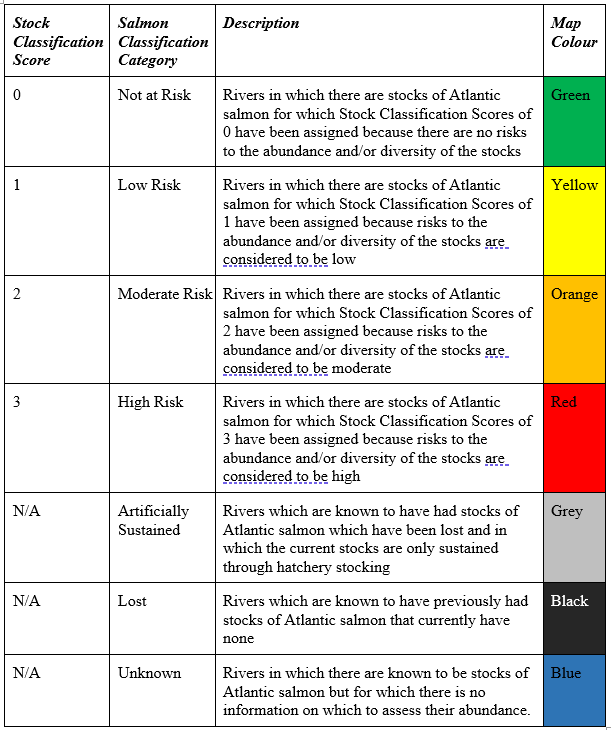NASCO Rivers Database
The NASCO Rivers Database
Welcome to the NASCO Rivers Database.
Atlantic salmon occur in rivers from Spain and Portugal in the south to Arctic Russia in the north, on the eastern side of the Atlantic, and from New England, USA in the south to Ungava Bay in the north on the western side. Conditions in these rivers vary markedly as does the status of the salmon stocks they contain.
In the Rivers Database you can view salmon rivers on the interactive map including their stock status. The data included were provided by Parties / jurisdictions between late 2017 and early 2019. A total of 2,359 rivers are reported on. The three tables below explain the data provided. Not all Parties were able to populate all fields for all rivers.
- Table 1. The fields displayed and a description of the data in each field;
- Table 2. The stock classification system used by each Party; and
- Table 3. The stock classification score.
Table 1. The fields displayed and a description of the data in each field
| Field Name | Description |
| River | A river is named as the main stem of the system of rivers and tributaries where it reaches the sea |
| Salmon Stock Category | Status of the salmon stock relative to conservation limits, or, where these have not been established, other reference points or indicators of abundance |
| Country | Country |
| Region / Province | Region or province |
| Latitude | 2 digits of degrees plus 2 digits of minutes, zero-padded where required e.g. 0464, not 464 |
| Longitude | 2 digits of degrees plus 2 digits of minutes, zero-padded where required |
| Catchment Area | Square kilometres (km2) |
| Total River Length | Kilometres (km) |
| Axial River Length | Kilometres (km) |
| Accessible River Length | Kilometres (km) |
| Mean Annual Flow | Cumecs (m3s-1) |
| Main Impact Factors | A description of the main factors adversely affecting the salmon stock |
| Total Conservation Requirement | Total number of salmon |
| 1SW Conservation Requirement | Number of 1 sea-winter salmon |
| MSW Conservation Requirement | Number of multi-sea-winter salmon |
| Special Stock Characteristics | For example, run timing |
| Other Information | For example, details of any designations; protected areas |
Stock Classification
Many rivers are classified using the Stock Classification Score developed by the Working Group on Stock Classification, CNL(16)11. However, some Parties / jurisdictions used alternative approaches. The data included were provided by Parties / jurisdictions between late 2017 and early 2019. Details are provided in Table 2.
Table 2. The stock classification system used by each Party
| Party / jurisdiction | Stock Classification used |
| Canada | A ‘read across’ from national river assessments |
| Denmark (in respect of the Faroe Islands and Greenland) Greenland | Taken from the Implementation Plan |
| European Union (except Spain) | 2016 Stock Classification Score |
| EU – Spain | Taken from the Implementation Plan |
| Norway | 2016 Stock Classification Score |
| Russian Federation | 2016 Stock Classification Score |
| United Kingdom (except Scotland) | 2016 Stock Classification Score |
| UK – Scotland | UK – Scotland’s stock classification data have been generated by creating a simple read across from Scotland’s national gradings, which are defined by the probability of the stock meeting its conservation limit over a 5-year period. Further information is available here. |
| USA | 2016 Stock Classification Score |
The 2016 Stock Classification
For those rivers categorised using the 2016 Stock Classification Score, it is based on:
- Conservation limits Attainment Score (CAS): based on available information concerning the extent to which the conservation limit is being attained; and
- Impacts Assessment Score (IAS): based on a range of factors including: habitat degradation e.g. deterioration in water quality or obstacles to migration; over-harvest or selective harvest; diseases and parasites, e.g. sea lice; G. salaris; impacts on genetic integrity e.g. due to aquaculture escapees; or a steadily declining stock trend where the causes are unknown.
The CAS and IAS are added together to assign a Stock Classification Score to a river.
Table 3. The 2016 Stock Classification

Amalgamated data from the Rivers Database was used in the State of North Atlantic Salmon Report.
A history of the Rivers Database can be found in the Report of the Working Group on Stock Classification, CNL(16)11.
